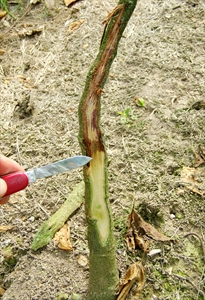Fruit rot, Phytophthora blight
Pacific Pests, Pathogens, Weeds & Pesticides - Online edition
Pacific Pests, Pathogens, Weeds & Pesticides
Passionfruit Phytophthora rot (154)
Phytophthora nicotianae; previously, Phytophthora nicotianae pv. parasitica. Note that in Fiji Phytophthora cinnamomi has also been reported as the cause of collar rot.
Phyophthora nicotianae is recorded from passionfruit from Fiji, Papua New Guinea (seedlings), Samoa, and Tonga. Phytophthora nicotianae is also reported from Australia, American Samoa, Cook Islands, Federated States of Micronesia, Fiji, New Caledonia, Niue, Papua New Guinea, Samoa, Tonga, and Wallis & Futuna on other hosts (see Fact sheet nos. 149, 157 & 264).
Passionfruit, cultivated and wild. Note, this is the same oomycete that causes a similar disease on tomato (root rot, and a firm dark fruit rot; see Fact Sheet no. 157), and also attacks capsicum, citrus (see Fact Sheet no. 264), papaya (see Fact Sheet no. 152), pineapple, and tobacco.
The disease is caused by a species of Phytophthora; it is an oomycete or water mould, not a fungus. Although they look like fungi, Phytophthora species are related to algae.
The disease is severe on young buds and leaves, causing blackening and death; light brown patches occur on older leaves. Vines can lose most of their leaves. On the stems, rots are purple at first, and later brown (Photo 1). If the rots circle the stems, the leaves wilt and the vines collapse and die. On fruit, grey-green areas occur mainly near the tips, later turning light brown (Photo 2). In wet weather, the rots are covered with white fungal growth. Roots are also attacked and rot.
The water mould lives in the soil. Spores develop there and in heavy rain they are splashed onto the leaves, stems and fruit. Further spread occurs when spores develop on buds and leaves and these are moved in wind-blown rain to other parts of the plant, and then throughout the plantation.
Depending on rainfall, the disease spreads quickly causing plants to wilt and die. In Samoa, it is a disease of passionfruit in the wet mountainous areas. Rots of 70% of the fruit have been reported after heavy rainstorms.
Look for a blight of buds and young leaves, and light brown patches on older leaves and fruits. Infections start near the ground. Look for rots on the stems, purple at first, and then light brown. Look for plants that wilt from stem or root rots.
CULTURAL CONTROL
Cultural control is particularly important in the management of this disease:
- Site: Do not grow passionfruit in very wet areas.
- Soils: Choose well-drained soils; Phytophthora has swimming spores that spread in water.
- Pruning: Prune vines to remove dead and weak sections; this will allow better air circulation and penetration of fungicide, if used.
- Hygiene: After pruning, collect the debris and burn it.
- Grass barriers: Grow grass strips under the vines to stop soil with spores splashing onto leaves, stems and fruits.
RESISTANT VARIETIES
The yellow (or golden) passionfruit is resistant to Phytophthora and should be used as a rootstock. Make sure that the graft is at least 30 cm above soil level to reduce the chance that soil splash will reach the leaves, stems and fruit.
CHEMICAL CONTROL
Where this disease is present - in countries that are hot and have high rainfall - chemical control may be required to obtain an acceptable crop. If fungicides are needed, use sprays of copper or mancozeb. Phosphorous acid is used in Australia under a minor-use permit either as a preventive spray (every 5-6 weeks) or curative spray (every 3 weeks).
____________________
When using a pesticide, always wear protective clothing and follow the instructions on the product label, such as dosage, timing of application, and pre-harvest interval. Recommendations will vary with the crop and system of cultivation. Expert advice on the most appropriate pesticide to use should always be sought from local agricultural authorities.
AUTHOR Grahame Jackson
Information (and Photo 2) from Gerlach WWP (1988) Plant diseases of Western Samoa. Samoan German Crop Protection Project, Deutsche Gesellschaft für Technische Zusammenarbeit (GTZ) Gmbh, Germany; and from CABI (undated) Phytophthora blight on passion fruit Phytophthora nicotianae var. parasitica. Plant Knowledge Bank. (https://www.plantwise.org/knowledgebank/factsheetforfarmers/20137804235); and from DAF (2016) Managing passionfruit plantations affected by wet weather. (https://www.daf.qld.gov.au/__data/assets/pdf_file/0016/57202/factsheet-passionfruit-and-wet-weather.pdf). Photo 1 Diseases of vegetable crops in Australia (2010). Editors, Denis Persley, et al. CSIRO Publishing.
Produced with support from the Australian Centre for International Agricultural Research under project PC/2010/090: Strengthening integrated crop management research in the Pacific Islands in support of sustainable intensification of high-value crop production, implemented by the University of Queensland and the Secretariat of the Pacific Community.





